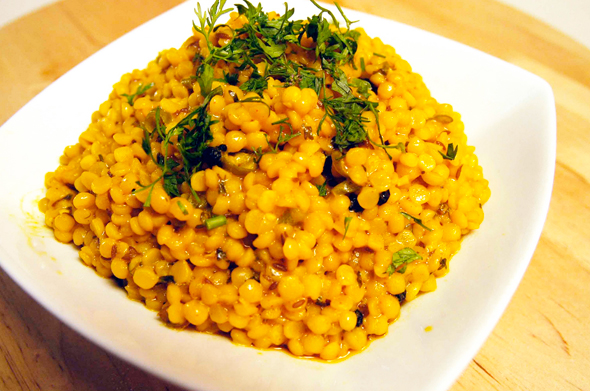Mama’s Punjabi Recipes: Sukkhi Dhuli Urad di Dal (Dry Skinless Urad Lentils)
Saved under Community, Current Stories, Recipe Corner
Tags: Baytown, Clear Lake, Cypress, Desi news, Greater Houston, Houston, Houston Desi news, India, Indian American community, Indian News, Indians in America, Indo-American News, Katy, NRI, pearland, south asia, South India, Sugar Land, Texas, USA
Daals of all types are so central to Indian cuisine and the Punjabi style of daals has to be the tastiest. By popular demand, below is a reprint of Mama’s Sukkhi Urad di Daal recipe which is not normally available in most Indian restaurants … unless it happens to be a dhaba in Delhi or the Punjab. It is reprinted with some additional information and directions.
Lentils are to Indians what meat is to many Americans. It is a staple for most people in Indian – both vegetarian and non-vegetarian – and the source of most of their protein and in fact, a meal is often not considered complete without a lentil dish. Whereas soya beans have about 43 gm of protein, 21 gm of carbohydrates and almost 20gm of fat, lentils usually range between 20 and 25 gm of protein, but 50 to 60 gm of carbohydrates and only 1 to 1.5 gm of fat. Some lentils like urad and moong are quite high in calcium. All dals are also rich in B vitamins thiamine and folic acid as well as minerals like iron and zinc.
Dals come in a rainbow of colors and tastes. There is the green moong dal; the yellow pea like channa, toor (also called arar dal) and dhuli (skinless) moong; the black cylindrical urad (known in Punjabi as mahn); the red flat masoor; the brown round mauth. Punjabis usually stick to the whole moongi, whole mahn or split mahn and channa (also called chole ki dal). There are about 50 varieties of dals (also called pulses) in the Indian Sub-continent.
According to Punjabi tradition, some dals like masoor are eaten only in the cold months as they are considered warm. Others, like the dhuli (skinned) urad are ground into a powder and deep fried to make bhallas and South Indian vaddas, The channa dal is ground into besan flour which is used all over India as a batter to coat vegetables, paneer and even bread and then fried to make a moist but crispy snack eaten with chutney.
Most Punjabis eat their dals in a thick stew with plenty of spices like adrak (ginger), lasan (garlic) and hing (astafoetida powder) which has to be sparingly due to its strong fetid smell and flavor but is an Ayurvedic medicine that is a good digestive and reduces gas. Other preparations are to make dry dal dishes, like this one, which can be eaten as a snack or with roti.
Ingredients:
• 1 cup dhuli urad dal (skinless lentils)
• 4 cups pani (water)
• 1 tsp namak (salt)
• 1 tsp haldi (turmeric)
• 2 tbsp tael (vegetable or olive oil)
• Pinch of hing (astafoetida)
• 1 medium adrak (ginger) – peeled and chopped
• 1 medium piyazz (onion) – peeled and chopped
• Spices (to taste): namak (salt), mirch (red pepper), hare dhania patta (shredded green coriander leaves)
Directions:
1. Wash the dal and let it drip. Place it in a saucepan with the water, salt and turmeric and let it come to a boil over medium high heat for 5 minutes or until the dal is soft and cooked.
2. Drain the water out in a strainer and let the dal sit for 5 minutes.
3. In a kadai (wok) or large saucepan, heat the oil then add the hing, ginger and onion and brown slightly.
4. Throw in the boiled urad dal, cover the saucepan and let it cook over medium heat for 5 minutes.
5. Add the other spices to taste and serve with roti and yogurt.
MAMA’S TIP OF THE WEEK
MAKE CRISPIER POORIS FOR THAT SPECIAL WEEKEND BRUNCH
A typical desi Indian brunch can be heavy on spices and carbs since it probably contains dishes like dosas, idlis, aaloo burji (smashed potatoes) and chole (white chickpeas curry) with pooris (fired puffed bread) or paranthas (flat roasted wheat bread) . One of the most popular is a garma-garam (hotter-than-hot) poori right off the kadai (deep wok) with chole.
But what makes the dish exceptional is having a really crispy poori. And the trick to doing that is to add a little rice flour in the wheat flour while kneading the dough. The rice flour adds just the right amount of starch to make the poori puff up and stay that way as you serve them.

Shakuntla Malhotra is a skilled cook of Punjabi dishes made in the old-fashioned style that she learnt as a young woman in her ancestral home in Lyallpur (since renamed Faisalabad), India before it became part of Pakistan after the Partition in 1947. People have often admired her cooking for its simplicity and taste that comes with each mouthful. Even in her mid-eighties, she continues to cook daily and agreed to share some of her delectable Punjabi recipes

